Today’s Making
My corner desk is completely finished with all the protective coats needed to keep it smooth through the decades ahead. This spalted beech came from a friend who sold it knowing he would never be able to use it. I’ve had it now for four years and confess I had no way of knowing what lay beneath the rough exterior to each board. I am that to some this interior wood will be like Marmite –– some will love and some will hate it or indeed my use of it in my house for this particular application or whatever. The wood grew on me. It wasn’t instant love but in the end it suited my need and the rarity and scarcity along with its different look pleased me.
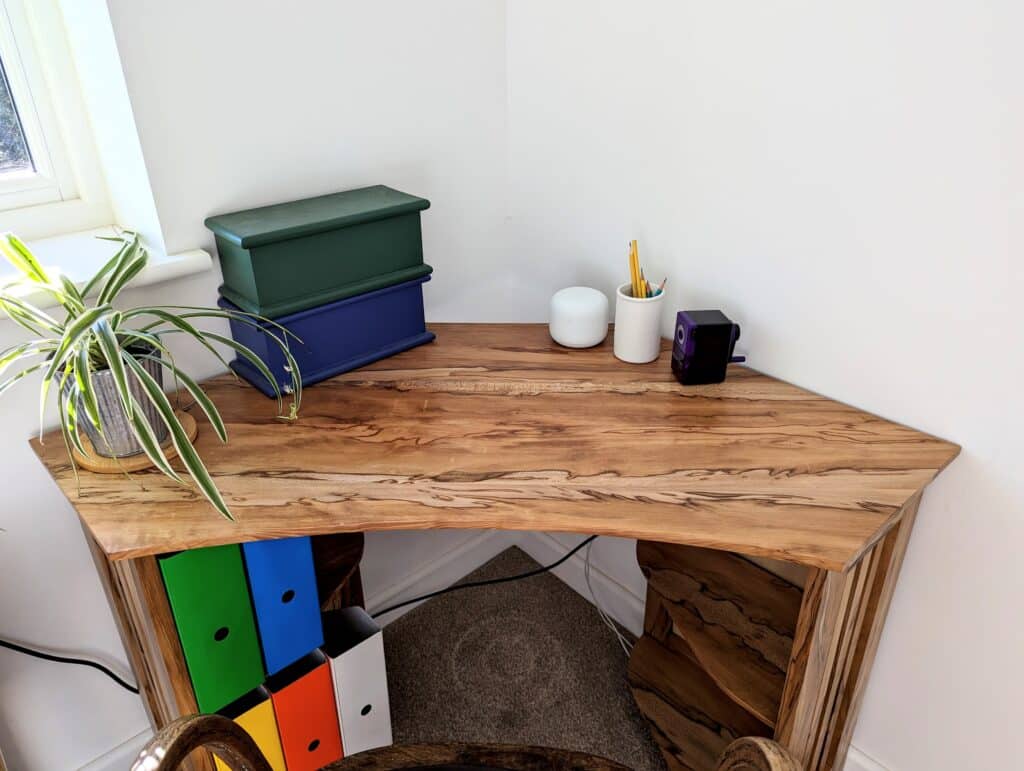
The first thing I made using this more unique beech came after the four years of owning the wood and allowing it to acclimate in my workshop. What was wet and flat when it came cupped and bowed with a twist here and there and I was glad to let it go its natural way knowing that once straying that way it would settle and never return to its awkward nature in a finished piece of work. I took a small piece from a shorter length for one of my first prototype router plane designs. My first router plane came from a spruce stud and some components I found and bought online. This beech version wasn’t picked for the grain patterns, colour and configuration but for the beech wood itself it being the single most traditional choice of British plane makers for several centuries. Making my corner desk from several boards I now have but half a half dozen boards left and these too will likely go into another Sellers’ home project or two.
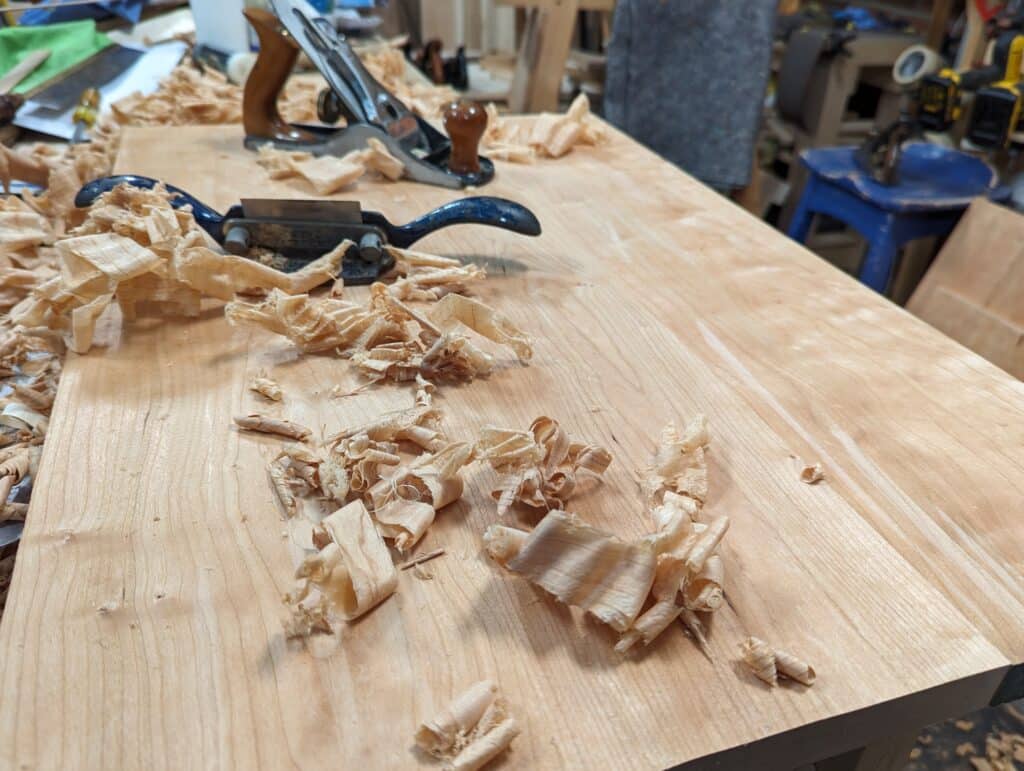
Currently, I am working on a complementary cabinet for hanging files with a couple of useful drawers for the everyday stuff of a home office together with neatness and order. The top will not be seen because the top will support an office printer too. 8I’m using cherry for the primary wood but will use the spalted beech as a tie between the two pieces and as a complementary wood to the desk. Beyond that, I will make some nice accent pieces like a desk lamp or some kind of holder/container for desk accessories –– my mind starts racing here!
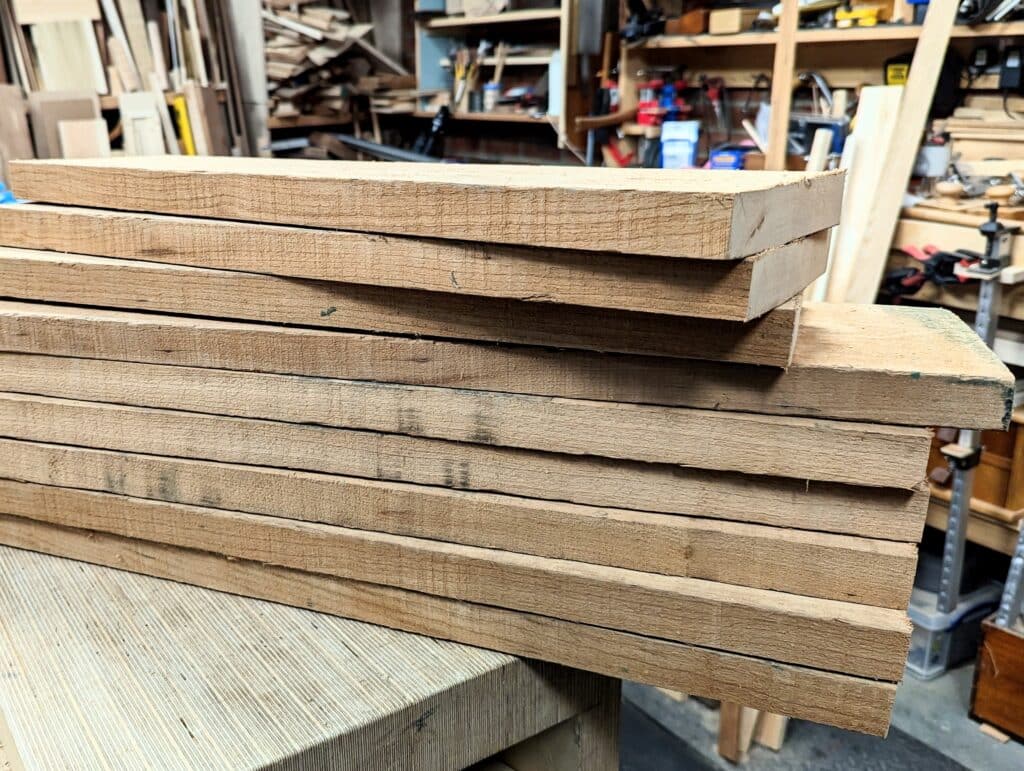
Last night I glued up my cherry panels, two sides and a top, for the next cabinet I am on. They look quite bland compared to the busy eccentricity of the desk so adding spalted beech somehow and somewhere will be my challenge. First thing this morning I sharpened my scrapers ready to refine the levels and prepare for joinery. Here, I have choices to make too. What joinery will I choose and use? I have some new ideas for as-yet-unseen joinery, just to complicate things or perhaps simplify them. I see this stage as a phase in composition. How will the joinery flow and how will it work with the interconnecting parts? At 5 pm last night, I decided to take my three rough-sawn pieces of cherry and make the last panel after declaring ten minutes before that I was done for the day and would do the last one tomorrow. At 5.45 pm I cooked dinner with the last panel left behind glued up in three clamps. Cherry is so much easier to work than the spalted beech but even so, I doubt that many could take rough-sawn wood, surface plane to remove defects like twist, cup and bow from 6`’ wide boards with hand planes and bring them to an equal thickness of 22mm (to with fractions of a millimetre) and square everything up in a glued up panel. For some reason, this work just flowed from me and it’s not everything that always goes that way. Maybe it was because I was tired.
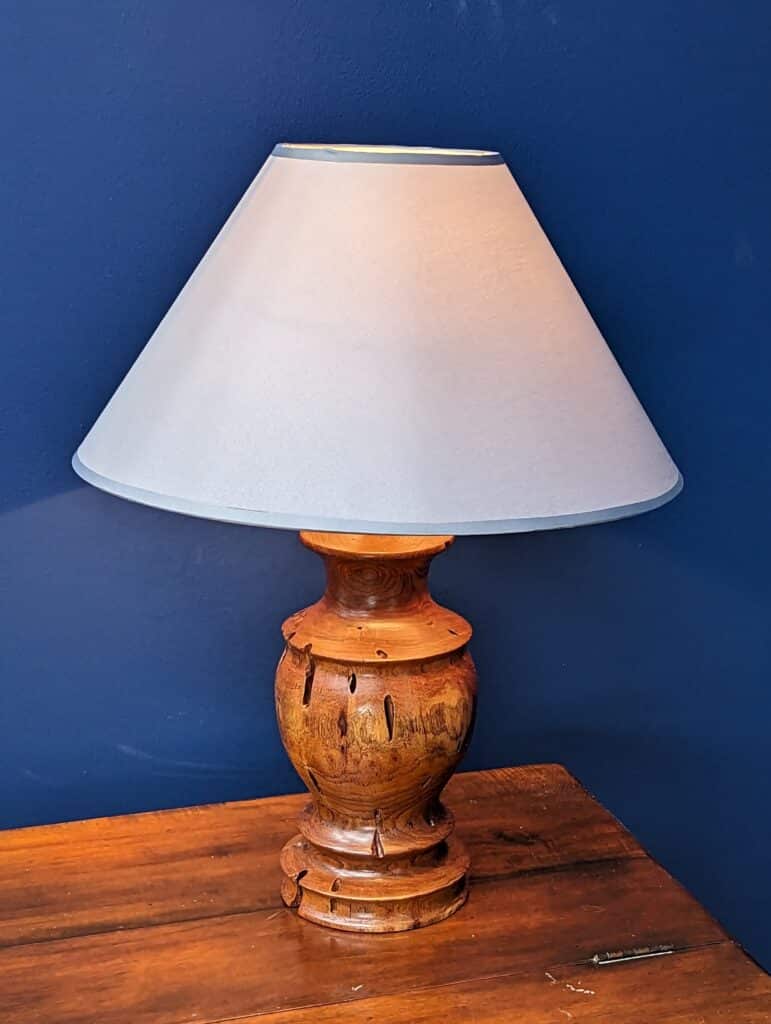
I’m looking forward to today. Prepping my wood by hand is my warm-up. I like to do this first thing to get my heart pumping. My brain is racing again now as I plan the stages for the day. I am not alone in the work because, of course, we will be filming and part of my planning includes how best to get which shots for the camera. My new desk no longer hovers in the background waiting for me to take its place upstairs in the house. It’s in the new sitting area as a functioning desk. It brings order to domestic bill paying, writing, researching, drawing or whatever. Down below I also have my garage workshop to make my upcoming project in. Here I also draw, write, make furniture or create whatever. It takes time to settle a workshop area…years, really. Each tool added takes its place and takes up highly valuable space. I no longer allow excess things. I add what’s valid and valued in my working. I have three metres by five metres in which to do all that I do in a day. I can move my bandsaw for space and to cut. It’s on wheels for that reason.
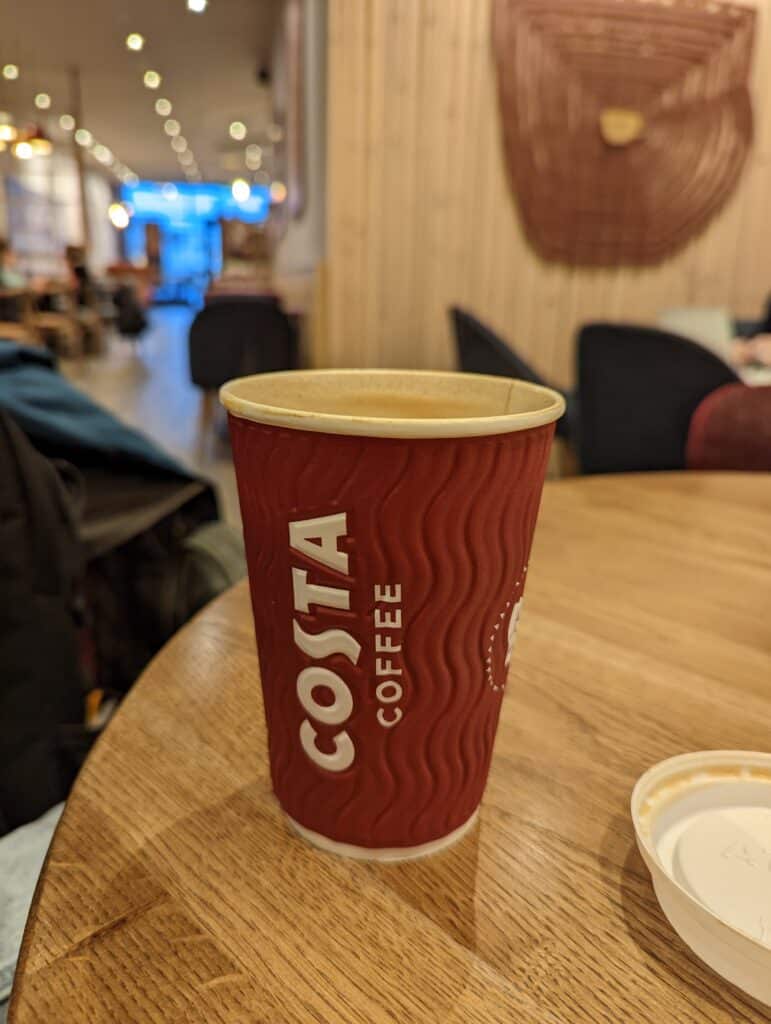
I have just finished my morning coffee in the cafe where I write every morning for a couple of hours. Before I got here I cycled for half an hour to an hour. That’s an eight- to sixteen-mile (13 kilometres) ride depending on my mood, the weather and time. There is very little that parallels delivering a piece of furniture to a home or office. All the planning you did comes together in this one act. The walls were indeed square so the two sides of the desk slid neatly up against the two adjacent walls. The space I allowed for traffic using the landing and the stairs could not have been accommodating and better used. The curve to the front edge of the desk seems as complementary as the overall functionality of the desk for working at.
I am happy with the wood but it would have been equally as nice in just about any wood you care to choose. Oak would have been nice as wood the pine prototype I made from studs. paint that graphite grey and spray with a top coat of clear finish or a ragged-on jell finish and it would also look pleasing. perhaps that’s what I will do with the prototype now and use it somewhere else in the house. I like the corner desk for different reasons not the least of which is how it uses an otherwise little-used and almost blocked-off space in a home or office.


Clever idea: this curved corner desk.
Better than a rectangular one along the window; it leaves a curved path for traffic which is curved by essence.
But how much space does the chair take?
Would you make a folding chair or a stool (not for long work) ?
I’m on it. Definitely no way a folding version, hate them! The design I come up with will work.
Great result Paul. Love the design, but what brings it alive is the choice of the timber. Love the spalted beech, there again I love any timber that is spalted, it’s the uniqueness and random patterning that appeals to me. By the way great idea about the pine prototype, charcoal grey is an excellent choice …
Many regards Paul
Desk looks very nice. Happy whenever you show us something new. One joint I’ve never see you make is that mitered blind dovetail.
And you likely won’t, Joe. I always felt like it was more pretentious than of much value; I put it in the realms of claw and ball foot on chairs. Total pretence demanded by the overlords of the day. I bought a lovely oak fall-front desk, beautifully made, and still own it that had mitred dovetails. I only bought it because of how well it was made and couldn’t stand to see it binned. The design was 1950s. I made a few small changes to it and it really is an office in itself but of course the office of the proletariat is the ubiquitous cell phone now. No keeping paper accounts in files for seven years these days and who writes letters anyway any more? But my granddaughter sends me notes and pictures she’s drawn and I keep them in a file with her name on it.
I’m already in my late sixties and use my cell phone and computers a lot, but at the same time I think there’s no substitute for pencil and paper when doing designing.
In my working life I’ve seen many young people in the company I worked for (real estate development), doing sketching on their computer. Or at least, trying to do so…
Terribly slowing down the process of transferring an idea to paper and also locking them into their first thoughts instead of erasing and improving their first lines if needed.
Many thanks from The Netherlands for sharing your knowledge!
Thanks Paul for the feedback. I didn’t realize the backstory. I had thought of it more as like the fox wedge tenon as something hidden that gives the apparent joint more strength.
Notes from your granddaughter are precious indeed.
i love that rich orange cherry i see in the old Maine joiners’ chests. yet the trees themselves are gnarly and pitchy with these great cracks in their bark…funny to think so.ething so orderly comes from a chaotic witchy looking plant! back home we had a “trash” wood called chokecherry and thats what the papermilks called it. the lumber came out looking like white ash…which is harder to get now with the emerald ash borer…little shites. an old hippie buddy built saunas of it and all kinds of things. good wood! we livw well on the corporate trash heaps haha. my home state used to have elms great gorgeous proud trees…dutch elm came and wiped out most. you see the grand elms on old pastures hither and yon. majestic!!
The fact is the society who send you a bill doesn’t want to pay for the paper (and postage) and for them as it has been computer generated, the extra (electric) energy to send it electronically is marginal.
On the consumer side it is an additional burden to save it electonically with the risk of loosing it and/or printing it locally. It might not always be possible to ask for a (electronic) duplicata later and, if it is a bit old, getting it free of charge.
How do you do if you relative dies and you don’t have his/her codes?
While no paper is supposed to save trees, the usage of computer and smart phones uses more energy than the whole air transport industry.
Actually, they said that the computer would indeed lead to less paper when in reality they ended up using four times more for a long period because runs and reruns became so easy and mistakes went undetected so four hundred copies with wrong info and typos simply meant correcting the mistake and sending to print again. we have improved in that we often let erroneous info go these days and grammar is less of a consideration in favour of speed. What we overspent on in the 1990s contributed to the expanse of lost trees for a couple of decades worth. Will we catch up and be in credit? I doubt it but my generation will not be paying the price of it. This is more what is heartbreaking.
Paul,
That corner desk is a real stunner.
Here in Texas, spalted pine is easily come by in big box stores. I just don’t know how best to finish it because the gray-green tinge doesn’t appeal to me. Do you have any suggestions?
I’m a retired computer programmer. I really wish I had begun investing in paper stocks when I first heard the phrase “Paperless Office”.
when i studied IT in the early 90’s as an older student, i remember them telling us that paperless offices were the future. it turned out they now use more paper than they did before.
Interesting, I only came across the mitred dovetail this month, in an old woodworking book. It looked overly complex for my limited skills and rather daunting, so relieved to read your opinion Paul :). I’m still working up to a basic dovetail! 🙁
Great article, thanks :). Despite a background that includes several endurance sports, your impressive energy leaves me feeling worn out but smiling 🙂 You’re my woodworking hero 🙂
Beautiful grain and design Paul.
Nicely done.
This is the most attractive finished piece of spalted wood I have seen. The grain pattern nearest the front of the top has such a pleasant billowing, flowing look. It has taken me awhile to warm up to the look of spalted wood but after seeing this desk I’m thinking it has more to do with the discerning and practiced eye of the craftsman making the piece. Truly stunning.
That is one fantastic desk and so beautiful.
Love that unique mesquite lamp. Just did major cut back on one in my back yard but unfortunately none of enough girth for a replica.
That is a beautiful desk Paul. The end grain of the panels looks like it’s a different wood from the top, such is the spalting effect (or perhaps it’s just the light in the photo!), it’s fantastic. I’ve started protoyping my own desk recently. I’m going for a floor sitting desk, as sitting on a chair for 8 hours a day is doing me no good. I also want it to collapse down out of the way on the several days I don’t use it, as the room its in needs to be used as a bedroom/playroom when I’m not in it! I think I’ve got something workable, that remains simple(ish) and will hopefully look good, but the prototype will tell all. It’s the prototyping stage that I really wish I’d bought the coveted bandsaw, so I can bring something together far more quickly, but it’s good practice. I’m also cutting dovetails in the prototype for extra practice (as well as seeing how it looks). It’s good fun, and if it doesn’t work out, then it doesn’t work out!
Thanks for the inspiration,
Rico
Greetings,
Mr. Sellers,
Thank you for your enormous and valuable contributions to the world of woodworking. Any update on the release of the second edition of Working Wood 1 & 2.
The mesquite lamp is striking and beautiful! I’m curious; was this turned on a lathe, or was it shaped with hand tools (saw/rasp/shave/scraper)?
I turned it two decades or so ago when I lived in my home state, Texas, maybe nearer three.
Now this is interesting. I have a huge desk from a retired relative. Now being retired I understand the lack of it’s need. It is time to turn the old office into the new library.
Thank you for the idea.
Would you teach us more about judging and selecting spalted wood? Is there a point where there’s not enough body to the wood to work with it? Can very light (as in not dense) wood be treated to make it usable?
I find your comment about electronics more than a bit amusing!
I’m doing the layout of my shop after getting it cleaned (the previous owner left a mountain of dust EVERYWHERE), and my wife just shook her head when I insisted on using a paper and pencil to draw it out by hand. Call me a luddite, but it just works better for me.
Hmmn hmmn I have this issue (problem) of a pile of Scottish burr elm boards that are looking at me looking at them if you know what I mean. Sometimes I have to just flatten a little with the spoke shave to see a bit of the grain patterns – and then my plan for the wood starts changing. Paul I’d be interested in how you from rough sawn boards to the end use of a board, how do you work your way along that journey of feel and form? Much for me to learn I think.
Ta Simon Lucas (Aberdeen)
hi Paul I really like the desk and the spalted beech it as a lot of cool grain running through it and very appealing when the finish is applied I love spalted beech I have some myself I am using it to make the router plane not to sure it will work as it feels a very soft timber what’s your thoughts Paul
That looks to be a very practical and useful corner desk/table. It turned out very nice.
The picture crops off the bottom of the legs. Are there drawings available on your site somewhere? I do not see it listed in the blogs/
As always, a delight. Your mind, and the work.
Great idea on the corner desk. I am designing one now using (believe it or not) pallet board lumber. I found some decent Beech and Cherry board. I have to deal with the nail holes but I am trying to design it so most of the nail holes are hidden. J.R. (Ronn) Winn of Vermont – USA.
Paul:
Please take heart. Though it feels like all of us that know how to use a handplane are 70 plus years old, I’ve seen a dramatic increase in the number of younger woodworkers who have taken a real interest in developing hand tool skills. I firmly believe there are more folks under 50 today that can four square a board, glue up a panel, and prep the panel only using handplanes than there were 20 years ago. I credit this to availability of better tools and the information you and others provide on an ongoing basis. I’ve done several live local handplane demonstrations processing all kinds of wood and those demonstrations always draw a crowd and tons of questions. I found the best way to encourage people to try it is to put the plane in the hands of a newbie and work with them until they can successful flatten and square up a board. It usually takes 30 minutes to an hour to get them close enough for government work. Their eventual success puts in the minds of the observers that if that person can do it so can I. Keep up the good work and keep the faith. You are making a difference.
Having now enjoyed over 60 years of daily full time woodworking, woodturning and furniture making and designing I am in no way disheartened at all and have no right to be so, experience shows me that my craft will eventually die as have dozens and and dozens of others through the last hundred or so years. This comes from the onslaught of a continuous and relentless industrial revolution changing its image with the help of the technological digital age. It’s just a question of time and maybe even in my lifetime I will indeed see this era change to lose the craft altogether. But it doesn’t worry me as it once did. The making of goods like furniture and such will eventually see no person’s hands touching it even in the basic van delivery of such products. See how a very sophisticated car is made these days. It is but 110 years ago to date that the good old Henry built his Ford motor car moving production line. No human touches a car but barely during the production of it these days. Robots spray the most perfect finishes and perform the most amazing using task methods that are as consistently smooth in operation delivering a performance vehicle with glass-smooth perfection straight out of the spray nozzle and the manufacturers don’t have to deal with the mood swings of humanity, emotions and relationships of staff. It’s the same with inexpensive furniture. The only preservation and conservation of woodworking craft will be through the amateur woodworker and that too could be short lived I’m afraid. Your kind words are taken as intended which is to encourage and I am glad to have done what I have done over the last three decades but you cannot stop this thing called progress linked to the ideal of making money.
This is a prediction I sincerely hope you are wrong about. Given the number of your followers there must be many others like me that find handtool woodworking peaceful and enriching. So perhaps it will not die in your lifetime, and hopefully not even in mine (I’m 20 years younger), but you can take solace in the fact that it will not die at least until the last of your followers has gone.
I found your automobile anaolgy a bit humorous given the current UAW situation. If humans are not necessary for production, what does it matter if the workers strike? But I understand the bigger picture of your point … machines and automation are the norm, and work done by hand has been marginalized in favor of mass production. But we can hope that there will continue to be a market from people that see the value of handmade items.
You may have a point that it is only the amateur woodworkers that will continue the craft, but I hope that’s enough to keep it going for centuries to come. In any case you are certainly doing your part to preserve the craft, and several hundred thousand of your followers are eternally grateful for it. Thank you Paul!
Love the grain, love the design!
One thing I really like is the straight back of the desktop. That leaves a triangle of open space in the corner. What I’d do is put my waste bin in the corner there, so I could throw things away just by chucking them over the back of the desk. They’d land inside it more often than not, and it would make throwing things away more fun.
I like your comment, most amusing, perhaps you could design a triangular bin, though, how you make dovetails in wood joints beyond or below 90 degrees is beyond me!
Wouldn’t you just make it square?
it’s encouraging to see you use beech and I really like the look of the spalting. I have some from my parents farm (Ohio) so it has sentimental value. I’m new to wood working and it has been tough to work by hand. Seeing you use it gives me hope!